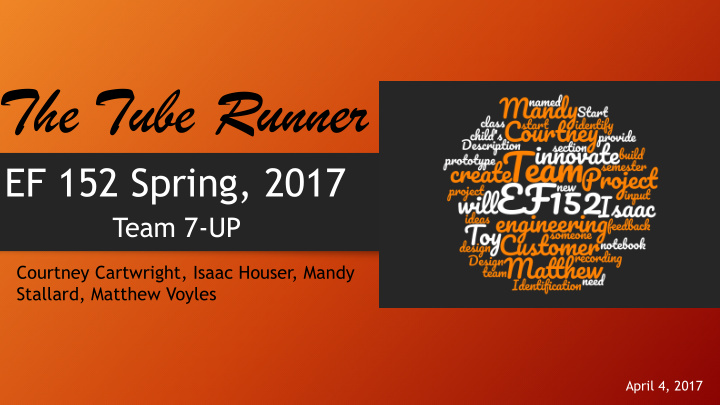



The Tube Runner EF 152 Spring, 2017 Team 7-UP Courtney Cartwright, Isaac Houser, Mandy Stallard, Matthew Voyles April 4, 2017
Customer Requirements and Product Selection • Our toy is geared towards children ages 7 and up. Our customer, a nine year old named Nick, was excited by the idea when we pitched it to him. He requested that there be a way to return the ball to the top without picking it up. • It could also be marketed to large toy production companies. • We chose this product because it is relatively easy to assemble, the materials were not expensive, and children responded positively to the idea.
Conceptual Design • Initially, the design featured a roller coaster made of wooden base with a metal track and a chain system to pull the cart to the top, similar to a roller coaster in real life. • However, as the design process progressed, we realized that using tubing for our track and a small steel ball to pass through was much cheaper, easier to build, and more feasible compared to the original idea .
Final Design • Our final design consisted of: • A wooden base • Wooden support beams of varying heights screwed/glued to the base • Plastic tubing for the track with PVC pipe to remove bends • A wooden return trough • 1 steel ball to run through the course • A pulley system and crank to return ball to the top of the track
Final Design Pictures Pulley System Support Beam Plastic Tubing Wooden Return Trough support PVC pipe block Pulley System
Final Design Explanation • We created our course to be as cost effective as possible, and attempted to minimize the amount of materials needed to produce 1 unit. • The steel ball and tubing provide the most streamlined and smooth material for the track. • The pulley system with the return trough is a fun and unique way to keep the course in motion as the customer requested while not straying to extreme monetary measure.
Marketing Video
Customer Feedback and Results • Our customer Nick was pleased and excited by the final product when we presented it. • He was very intrigued by the pulley system we used to return the ball to the starting point, and said that was the “coolest” part about the toy. • The coaster was able to run without issue the entire time the customer interacted with it.
Cost and Time Estimates Material Price 26x32.5 inch wooden base, 12,21,22 $12.00 (combined) and 29 inch wooden supports, 24 inch return trough, wooden support blocks PVC pipe $1.00 Hand crank $2.00 Pulley system $5.00 (combined) Spray paint $3.00 Small screws and zip ties $2.00 (combined) Steel ball and plastic tubing $6.00 (combined) Cost for 1000 units: $31,000 Total: $31.00 Man hours: 15 Retail: $40.00
Summary/ Conclusions • Our final design was successful, however if we had more time to build it we would have liked to incorporate a more realistic track and cart system. • We would also like to refine the structural stability by adding more screws to each wooden beam. • A continuously looping belt would have been added so that the roller coaster could have operated on its own, and the current pulley system would have been made more efficient. • More colors could have been used to make it more aesthetically appealing
Recommend
More recommend